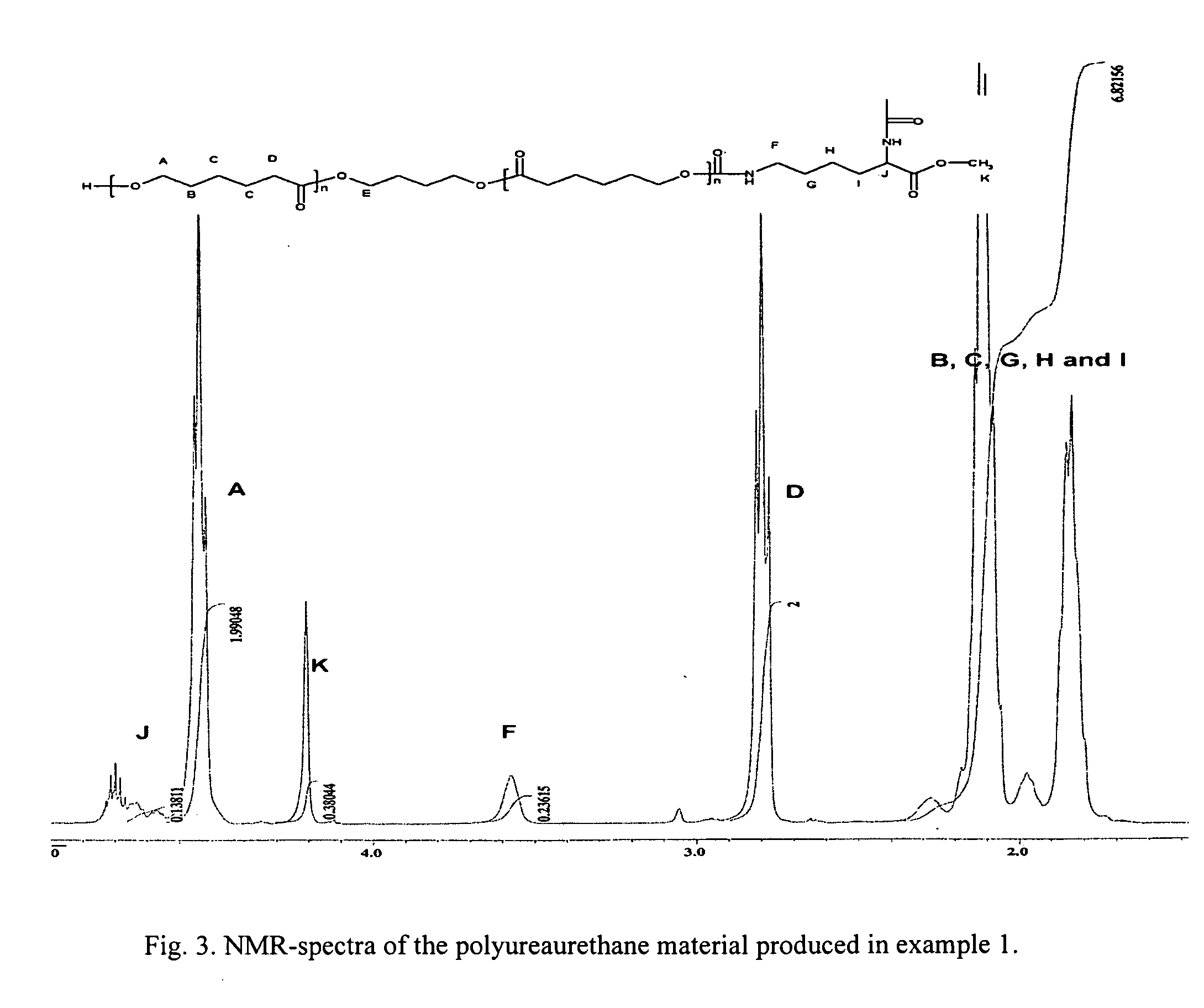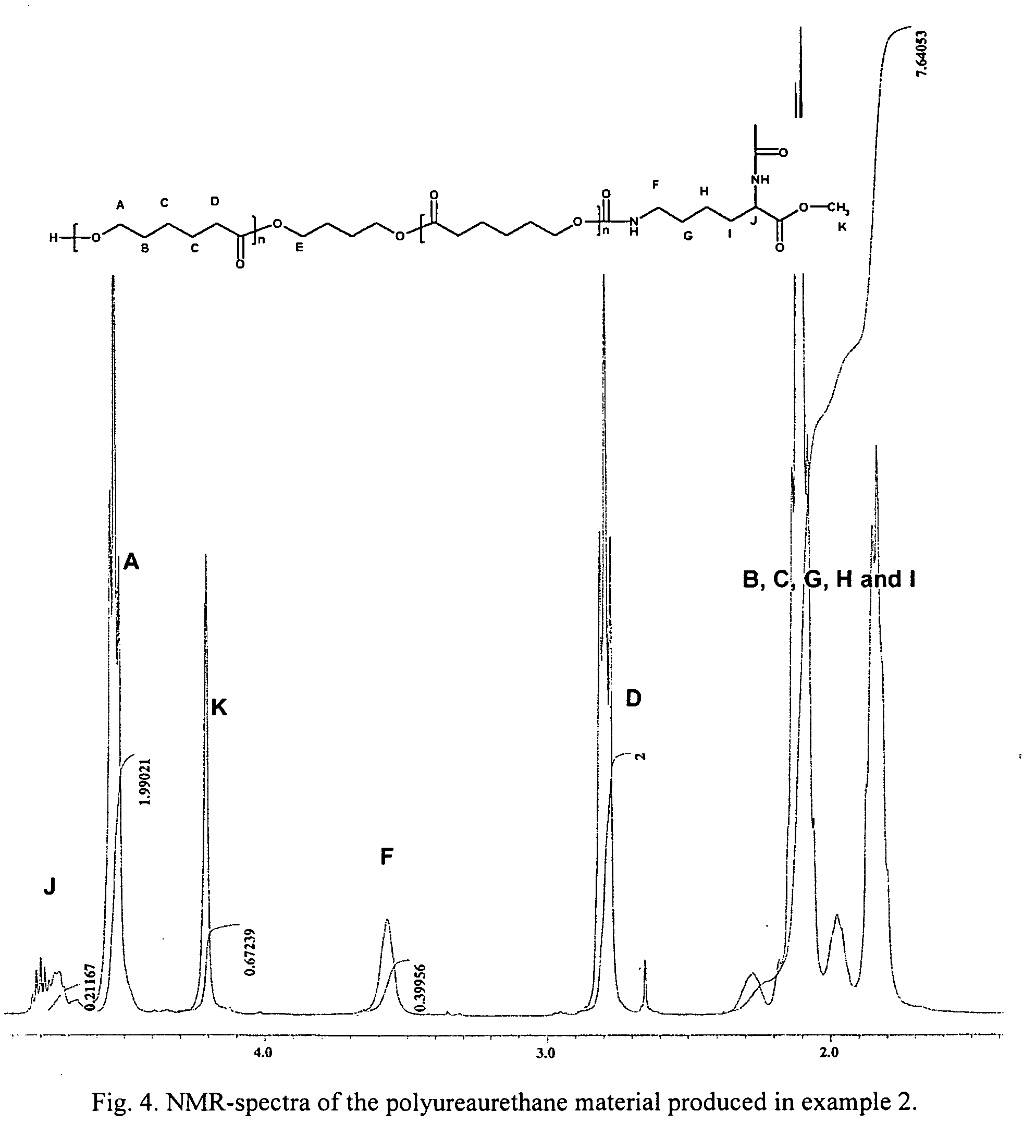Polyureaurethane material and method of producing a polyureaurethane material
a polyureaurethane and polyurethane technology, applied in the field of linear polyureaurethane polymer, to achieve the effect of convenient operation
- Summary
- Abstract
- Description
- Claims
- Application Information
AI Technical Summary
Benefits of technology
Problems solved by technology
Method used
Image
Examples
example 1
Production of a Polyureaurethane Material Synthesized by Using LDI and PCL, with a Mean Value of the Number of Diisocyante Derived Groups Present in the Hard Blocks Equal to at Least 4.8
Soft Block Component Synthesis
[0039] To a dried 250 ml round bottom flask, cooled under argon, was added in a glove-box, 28.58 g (0.251 mole) of epsilon-caprolactone, 0.68 g (0.0076 mole) of 1,4-butandiol and 0.12 g (0.3 mmole) of stannous octoate. The polymerization was performed at 110° C. for 24 hours. The product, the soft block component, was a two armed poly(epsilon-caprolactone) (PCL) having a OH-group at each end of the molecule, which was precipitated in methanol and dried in vacuum over phosphopentoxide, P2O5. The obtained PCL had a length, or a degree of polymerization (DP), of 40. The soft block component synthesis herein described, is a well known procedure in the art.
Prepolymer Component Synthesis
[0040] To a dried 250 ml three-necked round bottom reaction flask, was added 1.61 g (...
example 2
Production of Polyureaurethane Synthesized by Using LDI and PCL, with a Mean Value of the Number of Diisocyante Derived Groups Present in the Hard Blocks Equal to at Least 8
Soft Block Component Synthesis
[0042] The soft block component synthesis was identical to the soft block component synthesis as described in example 1.
Prepolymer Component Synthesis
[0043] To a dried 250 ml three-necked round bottom reaction flask was added 1.72 g (8.12 mmol) of LDI in the form of lysine methylester diisocyanate, whereupon 3.4 g (0.731 mmol) of the PCL produced in the soft block component synthesis dissolved in 20 ml DMF was added drop-wise during six hours and left over night with mechanical stirring, giving a molar ratio of 11.1:1 (LDI:PCL) and a dryness of approximately 25%. Thus, as a result, a prepolymer component was obtained.
Polyureaurethane Synthesis
[0044] The prepolymer component described above, was previously placed in the 250 ml three-necked round bottom reaction flask, which ...
example 3
Production of Polyureaurethane Synthesized by Using LDI and PCL, with a Mean Value of the Number of Diisocyante Derived Groups Present in the Hard Blocks Equal to at Least 9.8
Soft Block Component Synthesis
[0045] The soft block component synthesis was identical to the soft block component synthesis as described in example 1.
Prepolymer Component Synthesis
[0046] To a dried 250 ml three-necked round bottom reaction flask was added 2.21 g (10.43 mmol) of LDI in the form of lysine methylester diisocyanate, whereupon 4.02 g (0.865 mmol) of the PCL produced in the soft block component synthesis dissolved in 20 ml DMF was added drop-wise during four hours and left over night with mechanical stirring, giving a molar ratio of 12.04:1 (LDI:PCL) and a dryness of approximately 19%. Thus, as a result, a prepolymer component was obtained.
Polyureaurethane Synthesis
[0047] The prepolymer component described above, was previously placed in the 250 ml three-necked round bottom reaction flask, ...
PUM
| Property | Measurement | Unit |
|---|---|---|
| Temperature | aaaaa | aaaaa |
| Temperature | aaaaa | aaaaa |
| Temperature | aaaaa | aaaaa |
Abstract
Description
Claims
Application Information
 Login to View More
Login to View More - R&D
- Intellectual Property
- Life Sciences
- Materials
- Tech Scout
- Unparalleled Data Quality
- Higher Quality Content
- 60% Fewer Hallucinations
Browse by: Latest US Patents, China's latest patents, Technical Efficacy Thesaurus, Application Domain, Technology Topic, Popular Technical Reports.
© 2025 PatSnap. All rights reserved.Legal|Privacy policy|Modern Slavery Act Transparency Statement|Sitemap|About US| Contact US: help@patsnap.com



